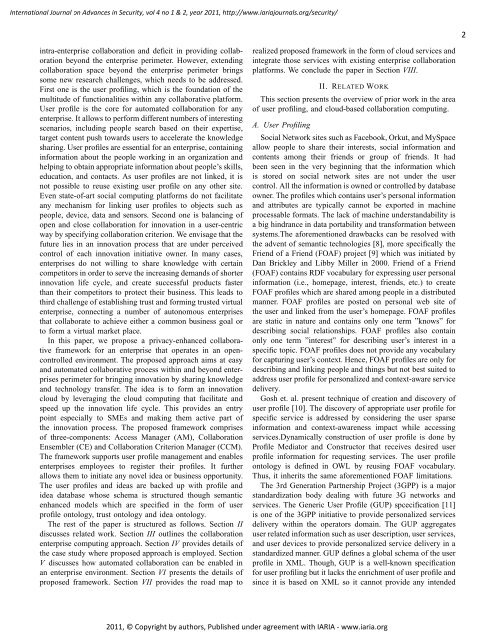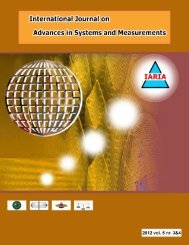Fault Tolerance Framework using Model-Based - IARIA Journals
Fault Tolerance Framework using Model-Based - IARIA Journals
Fault Tolerance Framework using Model-Based - IARIA Journals
You also want an ePaper? Increase the reach of your titles
YUMPU automatically turns print PDFs into web optimized ePapers that Google loves.
International Journal on Advances in Security, vol 4 no 1 & 2, year 2011, http://www.iariajournals.org/security/<br />
intra-enterprise collaboration and deficit in providing collaboration<br />
beyond the enterprise perimeter. However, extending<br />
collaboration space beyond the enterprise perimeter brings<br />
some new research challenges, which needs to be addressed.<br />
First one is the user profiling, which is the foundation of the<br />
multitude of functionalities within any collaborative platform.<br />
User profile is the core for automated collaboration for any<br />
enterprise. It allows to perform different numbers of interesting<br />
scenarios, including people search based on their expertise,<br />
target content push towards users to accelerate the knowledge<br />
sharing. User profiles are essential for an enterprise, containing<br />
information about the people working in an organization and<br />
helping to obtain appropriate information about people’s skills,<br />
education, and contacts. As user profiles are not linked, it is<br />
not possible to reuse existing user profile on any other site.<br />
Even state-of-art social computing platforms do not facilitate<br />
any mechanism for linking user profiles to objects such as<br />
people, device, data and sensors. Second one is balancing of<br />
open and close collaboration for innovation in a user-centric<br />
way by specifying collaboration criterion. We envisage that the<br />
future lies in an innovation process that are under perceived<br />
control of each innovation initiative owner. In many cases,<br />
enterprises do not willing to share knowledge with certain<br />
competitors in order to serve the increasing demands of shorter<br />
innovation life cycle, and create successful products faster<br />
than their competitors to protect their business. This leads to<br />
third challenge of establishing trust and forming trusted virtual<br />
enterprise, connecting a number of autonomous enterprises<br />
that collaborate to achieve either a common business goal or<br />
to form a virtual market place.<br />
In this paper, we propose a privacy-enhanced collaborative<br />
framework for an enterprise that operates in an opencontrolled<br />
environment. The proposed approach aims at easy<br />
and automated collaborative process within and beyond enterprises<br />
perimeter for bringing innovation by sharing knowledge<br />
and technology transfer. The idea is to form an innovation<br />
cloud by leveraging the cloud computing that facilitate and<br />
speed up the innovation life cycle. This provides an entry<br />
point especially to SMEs and making them active part of<br />
the innovation process. The proposed framework comprises<br />
of three-components: Access Manager (AM), Collaboration<br />
Ensembler (CE) and Collaboration Criterion Manager (CCM).<br />
The framework supports user profile management and enables<br />
enterprises employees to register their profiles. It further<br />
allows them to initiate any novel idea or business opportunity.<br />
The user profiles and ideas are backed up with profile and<br />
idea database whose schema is structured though semantic<br />
enhanced models which are specified in the form of user<br />
profile ontology, trust ontology and idea ontology.<br />
The rest of the paper is structured as follows. Section II<br />
discusses related work. Section III outlines the collaboration<br />
enterprise computing approach. Section IV provides details of<br />
the case study where proposed approach is employed. Section<br />
V discusses how automated collaboration can be enabled in<br />
an enterprise environment. Section VI presents the details of<br />
proposed framework. Section VII provides the road map to<br />
realized proposed framework in the form of cloud services and<br />
integrate those services with existing enterprise collaboration<br />
platforms. We conclude the paper in Section VIII.<br />
II. RELATED WORK<br />
This section presents the overview of prior work in the area<br />
of user profiling, and cloud-based collaboration computing.<br />
A. User Profiling<br />
Social Network sites such as Facebook, Orkut, and MySpace<br />
allow people to share their interests, social information and<br />
contents among their friends or group of friends. It had<br />
been seen in the very beginning that the information which<br />
is stored on social network sites are not under the user<br />
control. All the information is owned or controlled by database<br />
owner. The profiles which contains user’s personal information<br />
and attributes are typically cannot be exported in machine<br />
processable formats. The lack of machine understandability is<br />
a big hindrance in data portability and transformation between<br />
systems.The aforementioned drawbacks can be resolved with<br />
the advent of semantic technologies [8], more specifically the<br />
Friend of a Friend (FOAF) project [9] which was initiated by<br />
Dan Brickley and Libby Miller in 2000. Friend of a Friend<br />
(FOAF) contains RDF vocabulary for expressing user personal<br />
information (i.e., homepage, interest, friends, etc.) to create<br />
FOAF profiles which are shared among people in a distributed<br />
manner. FOAF profiles are posted on personal web site of<br />
the user and linked from the user’s homepage. FOAF profiles<br />
are static in nature and contains only one term ”knows” for<br />
describing social relationships. FOAF profiles also contain<br />
only one term ”interest” for describing user’s interest in a<br />
specific topic. FOAF profiles does not provide any vocabulary<br />
for capturing user’s context. Hence, FOAF profiles are only for<br />
describing and linking people and things but not best suited to<br />
address user profile for personalized and context-aware service<br />
delivery.<br />
Gosh et. al. present technique of creation and discovery of<br />
user profile [10]. The discovery of appropriate user profile for<br />
specific service is addressed by considering the user sparse<br />
information and context-awareness impact while accessing<br />
services.Dynamically construction of user profile is done by<br />
Profile Mediator and Constructor that receives desired user<br />
profile information for requesting services. The user profile<br />
ontology is defined in OWL by re<strong>using</strong> FOAF vocabulary.<br />
Thus, it inherits the same aforementioned FOAF limitations.<br />
The 3rd Generation Partnership Project (3GPP) is a major<br />
standardization body dealing with future 3G networks and<br />
services. The Generic User Profile (GUP) spcecification [11]<br />
is one of the 3GPP initiative to provide personalized services<br />
delivery within the operators domain. The GUP aggregates<br />
user related information such as user description, user services,<br />
and user devices to provide personalized service delivery in a<br />
standardized manner. GUP defines a global schema of the user<br />
profile in XML. Though, GUP is a well-known specification<br />
for user profiling but it lacks the enrichment of user profile and<br />
since it is based on XML so it cannot provide any intended<br />
2011, © Copyright by authors, Published under agreement with <strong>IARIA</strong> - www.iaria.org<br />
2







